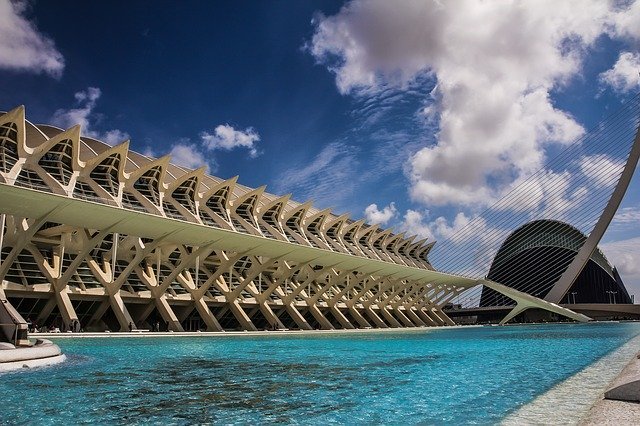
La Albufera
Check out our full guide to the La Albufera in Valencia. a spectacular as nature park, located just south of the center of the city of Valencia. … Read More
La Ciudad de las Artes y las Ciencias is a large complex dedicated, as the name indicates to the arts and sciences. This complex features several ultra-modern buildings and structures, each specializing in something different: performing arts, botany, marine biology, etc.
This city is located within the spectacular city of Valencia and it is one of it’s main attractions. It was built on what was once the riverbed of the Turia River. The river was drained and rerouted after a catastrophic flood in 1957. After that, the area was converted into a park.
Then, in 1996, two of Spain’s most renowned architects were commissioned to design, what would become, the City of Arts and Sciences of Valencia. The first piece to be completed was the Hemisfèric, which opened its doors in 1998. The Palau de las Artes Reina Sofia was the last major building to be inaugurated in 2005, and the project was fully completed in 2009.
The project’s original budget was €300 million, but it ended up costing 3 times that amount.
In July 1996 Ciudad de las Artes y las Ciencias, was born. The project, designed by the Valencian architect Santiago Calatrava, was carried out in the old Turia riverbed. But it took nearly a decade to build
The first building of the Ciudad de las Artes y Ciencias to be worked on was L’Hemisfèric, and construction began in July of 1996. The Palau de les Arts Reina Sofia was the last building to be completed on October 9, 2005.
After a catastrophic flood, in 1957, the river was diverted to the southern part of the capital and in the old bed, a ten-kilometer-long park was built that runs through the center of the city.

This is one of the most emblematic buildings of the complex. Shaped like an eye, it houses the IMAX theater, planetarium, and laser cinema projection room. It has an area of approximately 13,000 m².
This avant-guard interactive science museum occupies around 40,000 m² spread over three floors. It is one of the more popular and entertaining stops on a visit to the City of Arts and Sciences.
The Umbracle is an open-air promenade with native plant species of the Valencian Community covered by floating arches from where you can see the entire complex of the City of Arts and Sciences. It houses El Paseo de las Esculturas, an open-air art gallery with sculptures by contemporary artists. The Umbracle spans over 17,500 square meters.
This might be the main attraction of the whole complex. It is the largest oceanographic aquarium in Europe: over 110,000 square meters large and holding 42 million liters of water.
The building is shaped like a water lily-shaped, the work of the Valencia-born architect Adrián Peláez Coronado.

The structural design of the roofs is by engineers Alberto Domingo and Carlos Lázaro.
There are several different enclosures represented in the Oceanografic, each housed within its own building: Mediterranean, Wetlands, Temperate and Tropical Seas, Oceans, Antarctic, Arctic, Islands, and Red Sea, in addition to the Dolphinarium.
Reina Sofía Palace of the Arts houses four large areas: a Main Hall, Master Classroom, Amphitheater, and Chamber Theater. There is also a concert hall dedicated to music and the performing arts.
This futuristic-looking bridge connects the southern ring road with Calle Menorca, and its 125-meter-high pylon is the highest point in the city.
A covered square where concerts and sporting events were held, such as the new grand prize of the Valencian Tennis Community; but from 2020 onwards it will host the CaixaForum València
The Ciudad de las Artes y las Ciencias is categorized as one of the 12 Treasures of Spain. Other sites on the list include the Sagrada Família in Barcelona and Granada’s famous Alhambra.
The complex has also appeared several times in movies and TV shows. Scenes for the movie Tomorrowland, starring George Clooney were filmed there, and a full episode of Dr. Who was also filmed taking advantage of the futuristic setting.
The Ciudad de las Artes y Las Ciencias de Valencia also hosts a music festival every summer called the Festival de les Artes, a large local and international indie-focused music festival.
There is so much to see and do that we would suggest setting aside at least 2 days if you really want to experience everything the center has to offer.
Of the 6 buildings of the City of arts and Sciences, 4 are open to the public: The Oceanografic, the Principe Felipe Science Museum, L’Hemisfèric, and the Umbracle.
The Oceanografic is an open-air aquarium and the largest one in Europe at that. The 110 thousand square foot structure holds over 40 million liters of water and is home to 500 different aquatic species including marine mammals (dolphins, beluga whales, walruses, etc.), wetland bird species, aquatic reptiles, and of course an immense variety of fish, crustaceans and other sea creatures.
Due to the immense size of the center, you will need the whole day to see everything.
The Principe Felipe Science Museum is a 40,000-square-meter interactive science museum. You will find all types of interactive exhibits spanning everything from the human genome to space travel. Especially if you are visiting with children, you will need at least 4 hours to get the full experience.
Then there is the Hemisfèric and the Umbracle. The Hemisfèric features an IMAX cinema, a planetarium, and a laser show display. The Umbracle is an open-air structure that houses indigenous Valencian botanical species, and a collection of sculptures and contemporary art. You will need about two hours to visit both centers properly.
The Umbracle also features a brand-new disco, so you might have to set aside a good chunk of your evening as well if you feel like unwinding with some music and a cold drink.
It will take you about half an hour to get from the City or Arts and Sciences to get to the city center of Valencia.
Lorem ipsum dolor sit amet, consectetur adipiscing elit. Ut elit tellus, luctus nec ullamcorper mattis, pulvinar dapibus leo.

Check out our full guide to the La Albufera in Valencia. a spectacular as nature park, located just south of the center of the city of Valencia. … Read More

Check out our full guide to the L’Oceanogràfic in Valencia. L’Oceanogràfic is the largest aquarium in Europe and an essential visits while in Valencia … Read More
is proudly powered by WordPress